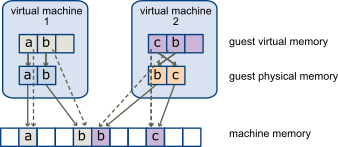There are two types of memory virtualization: Software-based and hardware-assisted memory virtualization.
Because of the extra level of memory mapping introduced by virtualization, ESXi can effectively manage memory across all virtual machines. Some of the physical memory of a virtual machine might be mapped to shared pages or to pages that are unmapped, or swapped out.
A host performs virtual memory management without the knowledge of the guest operating system and without interfering with the guest operating system’s own memory management subsystem.
The VMM for each virtual machine maintains a mapping from the guest operating system's physical memory pages to the physical memory pages on the underlying machine. (VMware refers to the underlying host physical pages as “machine” pages and the guest operating system’s physical pages as “physical” pages.)
Each virtual machine sees a contiguous, zero-based, addressable physical memory space. The underlying machine memory on the server used by each virtual machine is not necessarily contiguous.
For both software-based and hardware-assisted memory virtualization, the guest virtual to guest physical addresses are managed by the guest operating system. The hypervisor is only responsible for translating the guest physical addresses to machine addresses. Software-based memory virtualization combines the guest's virtual to machine addresses in software and saves them in the shadow page tables managed by the hypervisor. Hardware-assisted memory virtualization utilizes the hardware facility to generate the combined mappings with the guest's page tables and the nested page tables maintained by the hypervisor.
The diagram illustrates the ESXi implementation of memory virtualization.

- The boxes represent pages, and the arrows show the different memory mappings.
- The arrows from guest virtual memory to guest physical memory show the mapping maintained by the page tables in the guest operating system. (The mapping from virtual memory to linear memory for x86-architecture processors is not shown.)
- The arrows from guest physical memory to machine memory show the mapping maintained by the VMM.
- The dashed arrows show the mapping from guest virtual memory to machine memory in the shadow page tables also maintained by the VMM. The underlying processor running the virtual machine uses the shadow page table mappings.